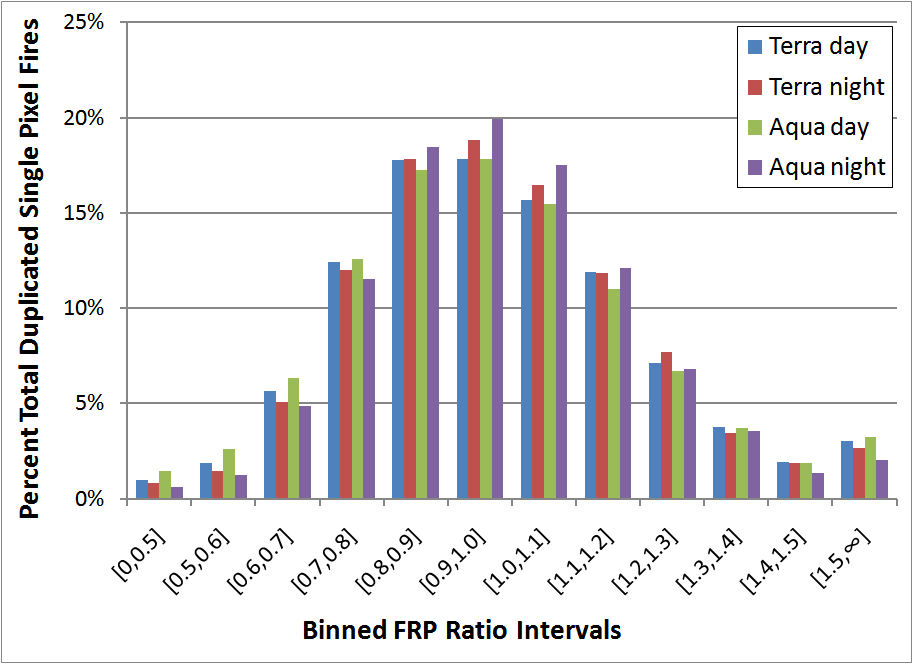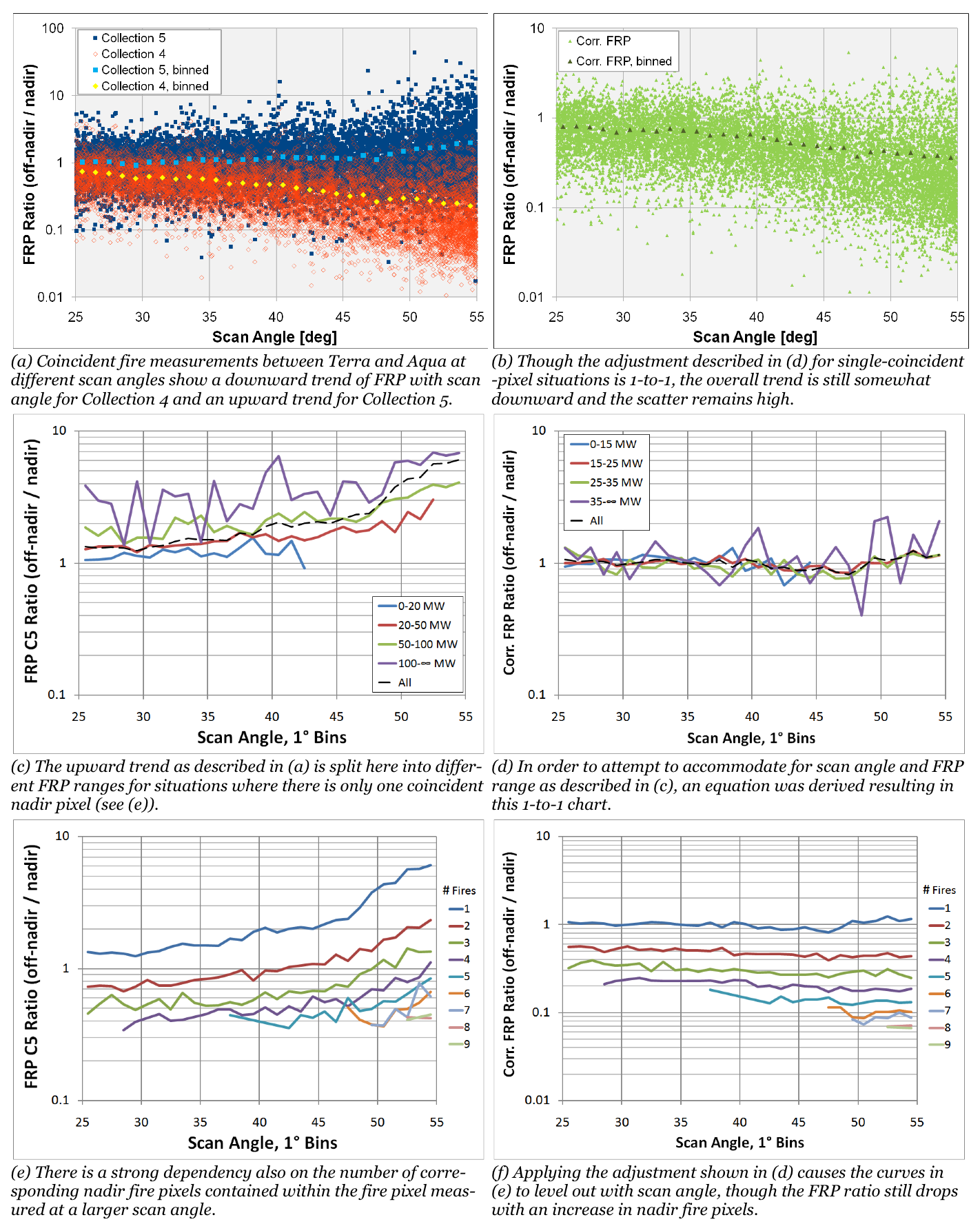National Aeronautics and Space Administration
Goddard Space Flight Center

Fire Energetics and Emissions Research
FEER Updates

20.Feb.2019 - VIIRS active fire data available as VNPFIRE product.
12.Feb.2019 - FEERv1.0 Emissions processing stream fixed.
08.Feb.2019 - MODFIRE processing stream fixed.
31.Jul.2018 - Suomi-NPP VIIRS fire data added to Africa Explorer.
Validation of the MODIS Fire Radiative Power Product
Current collections/versions of the MODIS Level 2 FRP product (MOD14/MYD14) have not yet been validated. Validation of this product shall be conducted using both an internal analysis between coincident data of the same fires between Terra and Aqua, and using airborne data to compare with MODIS measurements. Any resulting algorithm will be incorporated into a production of new data files to be made available in the data section of this website.
Duplicate MODIS Fire Detections

Figure 1: MODIS scans (shown in alternating colors) overlap each other due to the “bow-tie” effect. A general algorithm can remove these overlapping pixels.
Multiple fire detections are often made of the same fire in subsequent MODIS scans due to the “bow-tie” effect, or rather, the fact that a given detector covers greater ground area off-nadir. Since FRP measurements are not gridded data but are rather distinct data points, this is an issue that most always needs to be dealt with in the following analyses.

Figure 2: FRP ratios of identical fires measured on subsequent scans are binned as shown to intervals of 0.1 for all single-pixel fires in the years 2003-2009.
A general algorithm to remove duplicate fires was developed that is not dependent on any specific fire pixel's characteristics but rather was derived using assumptions of a perfectly smooth Earth surface so that it can be applied to a set of fire data based on a pixel's location within a granule instead of its position on the Earth. Table 1 shows what fires fall within the valid range of sample indices of a MODIS granule, and Figure 1 shows the effect of applying this algorithm to a section of overlapping MODIS pixels. In order to check the validity of applying this general algorithm to MODIS fire data, single-pixel fires' FRP values were compared against their duplicate values and these ratios were binned into 0.1 intervals as shown in Figure 2. The resulting bell shaped curve implies that, generally speaking, it is acceptable to simply remove a “random” duplicate fire pixel using this algorithm.
| Track # of Scan | 0 | 1 | 2 | 3 | 4 | 5 | 6 | 7 | 8 | 9 |
|---|---|---|---|---|---|---|---|---|---|---|
| Valid Range (sample) | 465-888 | 199-1154 | 111-1242 | 35-1318 | 0-1353 | 0-1353 | 0-1353 | 0-1353 | 0-1353 | 308-1045 |
| Equivalent Scan Angles | ±17.2° | ±38.8° | ±46.0° | ±52.1° | ±55.0° | ±55.0° | ±55.0° | ±55.0° | ±55.0° | ±29.9° |
FRP Measurement Variability

Figure 4: Comparisons between Terra and Aqua FRP measurements are shown above. Single-pixel fires at larger scan angles are compared with the sum of corresponding nadir FRP values of the same fire measured by the other satellite. Collection 5 values are shown in the leftmost column, and adjusted values based on an equation dependent on scan angle and FRP are shown on the right.
When Collection 5 was created, which incorporates the pixel area term into Collection 4 data so as to get true power measurements, the difference became apparent when plotting FRP over different scan angles (see Figure 3). The flatness of the min FRP Collection 4 curve is characteristic of the fact that there exist certain cutoff values in the fire determination algorithm that are constant. Currently the plan for the Collection 6 fire algorithm is to make these constant values vary according to scan angle. Consequently, because the area term is incorporated into Collection 5 FRP values but not in the fire determination algorithm, there exists a tendency for Collection 5 FRP to be higher off-nadir than at nadir.

Figure 3: Minimum FRP values are shown here verses scan angle for Collection 4 (without an area term) and Collection 5 (with an area term).
A more in depth analysis is being done to determine the true extent of FRP measurement variability in Collection 5. This has so far mostly been an internal analysis based on comparisons between MODIS on Terra and MODIS on Aqua over the same fires and measured within 20 minutes (corresponding to a lower limit of 53° latitude.) The effects that some of the different variables have on FRP measurements are shown in the first column of Figure 4. An effort was made to derive a variable factor, dependent on scan angle and FRP using comparisons of single-pixel fires, so that when multiplied against FRP values measured at larger scan angles, its adjusted FRP value will match the corresponding near-nadir measurement. The results for these adjusted FRP values are shown in the second column of Figure 4.
Supporting Documents
AGU 2010 Fall Meeting
Detailed Analysis of the EOS-MODIS Instrument's Fire Radiative Power Product
[poster]
Publications
Dickinson, M. B., Hudak, A. T., Zajkowski, T., Loudermilk, E. L., Schroeder, W., Ellison, L., … Mauceri, J. (2016). Measuring radiant emissions from entire prescribed fires with ground, airborne and satellite sensors – RxCADRE 2012, Supplementary material. International Journal of Wildland Fire, 25(1). doi:10.1071/WF15090_AC
Ichoku, C., Kaufman, Y. J., Giglio, L., Li, Z., Fraser, R. H., Jin, J.-Z., and Park, W. M. (2003). Comparative analysis of daytime fire detection algorithms using AVHRR data for the 1995 fire season in Canada: Perspective for MODIS. International Journal of Remote Sensing, 24(8), 1669–1690. doi:10.1080/01431160210144697
Ichoku, C., Giglio, L., Wooster, M. J., and Remer, L. A. (2008). Global characterization of biomass-burning patterns using satellite measurements of fire radiative energy. Remote Sensing of Environment, 112(6), 2950–2962. doi:10.1016/j.rse.2008.02.009
Ichoku, C., Kahn, R., and Chin, M. (2012). Satellite contributions to the quantitative characterization of biomass burning for climate modeling. Atmospheric Research, 111, 1–28. doi:10.1016/j.atmosres.2012.03.007
Peterson, D., Wang, J., Ichoku, C., Hyer, E., and Ambrosia, V. (2013). A sub-pixel-based calculation of fire radiative power from MODIS observations: 1. Algorithm development and initial assessment. Remote Sensing of Environment, 129, 262–279. doi:10.1016/j.rse.2012.10.036
Polivka, T. N., Wang, J., Ellison, L. T., Hyer, E. J., and Ichoku, C. M. (2016). Improving Nocturnal Fire Detection With the VIIRS Day–Night Band. IEEE Transactions on Geoscience and Remote Sensing, 54(9), 5503–5519. doi:10.1109/TGRS.2016.2566665
References
▼- NASA Official: Charles Ichoku
- Webmaster: Luke Ellison
- Page Last Updated: February 13, 2015
